Curious about what elevates a tennis match at night to an exciting spectacle? It’s the wonders of LED tennis court lighting that do the trick. This isn’t just about making the court visible; it’s about improvising every aspect of the game.
LED lights bring energy efficiency, superior visibility, and a glare-free environment to the forefront, making any tennis court a stage fit for professionals.
Installing LED lights on tennis courts is a breeze, all thanks to their modular design. This feature makes them a top pick for outfitting new courts and updating older ones that previously relied on metal halide or halogen lights.
The exceptional quality of light from LED tennis court lighting ensures that every moment of play, from serves to volleys, is brightly lit, keeping the tennis ball always visible. The article dives deeper into the nitty gritty of tennis court lighting and what you should know about it.
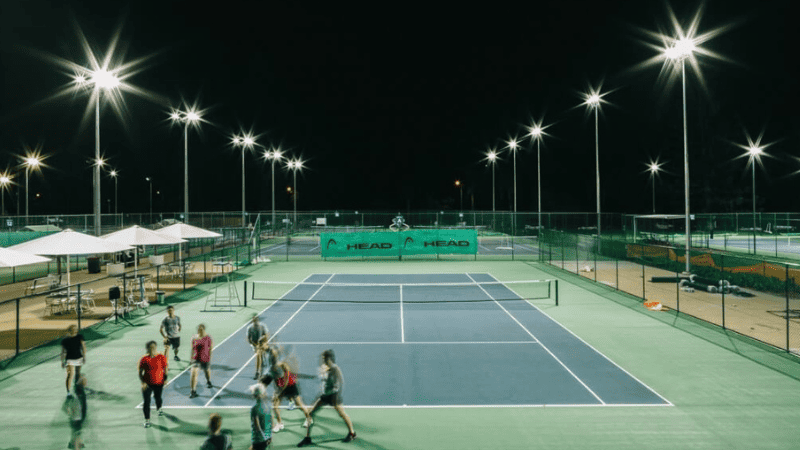
What Are Tennis Court Lights?
LED tennis lights offer bright, uniform illumination while cutting down on electricity use, making them a smart choice for outdoor and indoor courts.
Whether it’s a friendly game or a serious competition, this guide ensures your tennis court is well-lit, creating memorable experiences with every match.
LED technology has taken the lead over older lighting methods such as metal halide and halogen lamps by providing better light quality and longevity. These LED tennis lights are engineered to meet tennis court needs, offering uniform light that makes the ball and player movements easy to see.
Ask For Free Quote
Let us Respond Promptly for your Needs :)
Types of Tennis Court Lighting
Among the various types of lighting used, floodlights and high bay lights stand out for their effectiveness and efficiency.
1. Floodlights
Floodlights are widely favored for outdoor tennis courts. They cast a broad, powerful beam of light, illuminating the court evenly and reducing shadows that could hinder players’ visibility.
This type of lighting is essential for outdoor settings where natural light varies and can be insufficient for evening games.
2. High Bay Lights
On the other hand, high bay lights are the go-to choice for indoor tennis courts. Designed to light up large, open areas from a high ceiling, these lights provide focused illumination that covers the court uniformly.
They’re particularly effective in indoor arenas or sports centers, where they can be mounted at significant heights to light up the playing area without causing glare or discomfort.
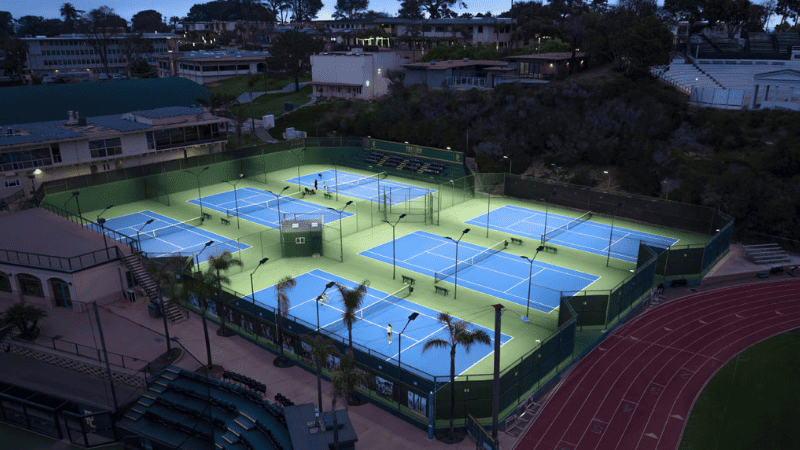
Both LED floodlights and high bay lights are well known for their energy efficiency, significantly reducing energy consumption and costs compared to traditional lighting options like metal halide lamps.
LED technology also offers superior light quality, with a brighter, more natural light that improves the playing experience. LEDs have a longer lifespan and require less maintenance, making them a cost-effective solution for tennis facilities.
Tennis court lighting layout
Designing the lighting layout for a tennis court with LED lights involves choosing the right number of poles and the maximum power of each light to ensure the court is evenly and adequately lit.
Below is a table that breaks down different setups based on the number of poles used and their impact on lighting quality:
| Number of Poles | Pole Height | LED Light Power | Average Brightness (Lux) | Suitable For |
|---|---|---|---|---|
| 8 Poles | 6 meters (20 feet) | 400W each | 783 lux | Standard-sized courts, competitive play |
| 6 Poles | 8.7 meters (29 feet) | 300W each | 500 lux | Versatile needs, balancing recreational and competitive environments |
| 6 Poles | 8.7 meters (29 feet) | 200W each | 300 lux | Recreational play, lower intensity requirements |
| 6 Poles | 8.7 meters (29 feet) | 200W each | 300 lux | Recreational play, lower intensity requirements |
| 4 Poles | 12 meters (40 feet) | 500W each | 419 lux | Smaller courts, focused illumination |
| 4 Poles | 12 meters (40 feet) | 300W each | 489 lux | Efficient lighting with fewer poles |
8 Poles
For a setup with 8 poles, each standing at 6 meters (about 20 feet) tall, equipping them with 8 MECREE LED lights of 400 watts each elevates the average brightness to 783 lux.
This arrangement is ideal for standard-sized courts (36 by 18 meters or 120 by 60 feet), providing a high level of illumination perfect for competitive play and broadcasting needs.
6 Poles
A 6-pole configuration, with each pole at 8.7 meters (approximately 29 feet), can be tailored to different lighting intensities.
Installing 6 MECREE LED lights of 300 watts each brings the average brightness to 500 lux, while using 200-watt lights instead drops the average brightness to 300 lux.
This flexibility allows for customization based on the court’s specific needs, balancing recreational and more competitive environments.
4 Poles
Lastly, a 4-pole layout, with poles reaching up to 12 meters (nearly 40 feet), offers another versatile lighting solution.
Using 4 MECREE LED lights of 500 watts achieves an average brightness of 419 lux. Alternatively, opting for 8 lights of 300 watts each can increase the average brightness to 489 lux. This setup ensures that even with fewer poles, the court receives sufficient light for most types of play.
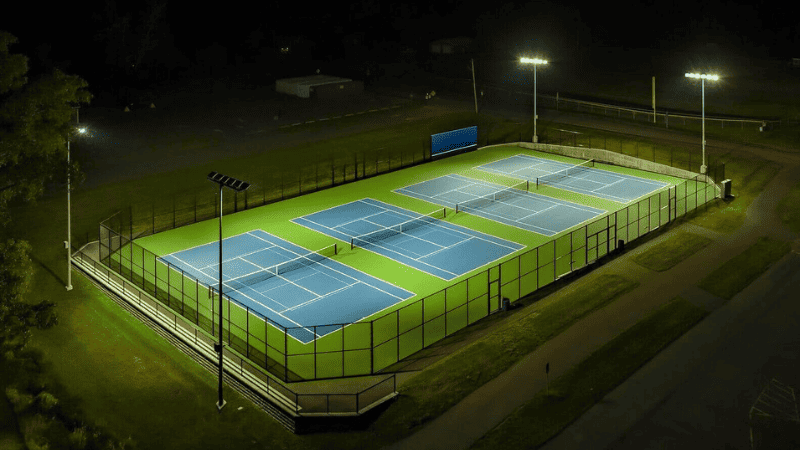
How Many Tennis Court Lights Do I Need?
Determining the number of lights required for a specific area, whether a tennis court, a parking lot, or an indoor tennis field, hinges on several key factors.
The application’s purpose, the space’s size, and the desired brightness level are crucial in this decision-making process.
1. Sports Facilities
For sports facilities like tennis courts, the standards set by governing bodies and the level of competition dictate the lighting requirements.
Recreational courts might need a more modest setup, focusing on visibility and safety, while professional arenas demand higher brightness levels to accommodate players’ performance and broadcast quality.
Ask For Free Quote
Let us Respond Promptly for your Needs :)
2. Commercial Spaces
In commercial spaces such as parking lots, the emphasis is on safety and navigation. Here, the goal is to install enough lights to ensure clear visibility, minimizing shadows and dark spots without causing glare or light pollution.
3. Indoor Spaces
Indoor environments, like warehouses or retail spaces, require a tailored approach to balance energy efficiency and creating a welcoming atmosphere for visitors or a productive environment for workers.
The height of the ceiling, the color of the walls, and the nature of activities taking place all influence the number and type of lights needed.

Requirements and Standards for LED Tennis Court Lighting
Setting up the right LED tennis court lighting involves understanding specific requirements and standards that ensure players have the visibility they need for the game.
These standards are categorized based on the competition level, ensuring the lighting is always optimal, from casual games to professional matches.
- For professional-level play, the lighting must reach at least 125-foot candles, or 1250 lux, providing the clarity needed for high-speed action.
- College and intermediate competitions require a brightness of 50-foot candles (500 lux), ensuring good visibility for players and spectators.
Ask For Free Quote
Let us Respond Promptly for your Needs :)
- High school competitions and private club matches have a slightly lower requirement of 30-foot candles (30 lux). In contrast, where the competition is less intense, recreational play needs a minimum of 20-foot candles (200 lux).
- The Association of Tennis Professionals (ATP) sets even higher standards for World Tour tournaments, demanding a minimum of 100-foot candles.
- For matches broadcast on television, the requirement jumps to 285-foot candles to ensure the action is clearly visible to viewers at home. This translates to a need for around 56,000 lumens for a recreational court and up to 280,000 lumens for a collegiate-level court.
LED sports lighting meets these requirements and significantly saves energy and maintenance costs. LED lights provide even, consistent illumination across the tennis court, enhancing the playing experience while being energy efficient.
Whether it’s a local club game or an international tournament, ensuring your tennis court meets these lighting standards is key to a great game.
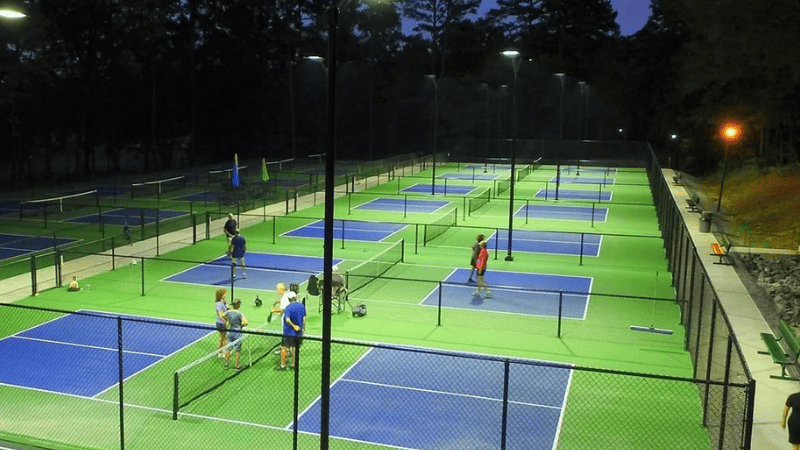
How to Select the Best Lighting for Your Tennis Court Lighting Fixtures
When it comes to LED tennis court lighting system, below points should be considered for better experience.
1. Luminous efficacy
Choosing the right lighting for your tennis court primarily focuses on the brightness level. Given the rapid pace of tennis and the ball’s small size, warm light intensity is crucial for players to track the ball effectively.
Opt for LED sports lights known for their high-lumen output, ensuring the court is well-lit. These lights should also feature adjustable brightness to adapt to various playing conditions, such as different times of the day or changes in weather.
This flexibility ensures players always have the best possible visibility, enhancing their concentration and performance on the court.
For example, selecting LED sports lights with a lumen output of 50,000 lumens can illuminate a standard tennis court brightly, making it easy for players to spot and follow the tennis ball during fast-paced games.
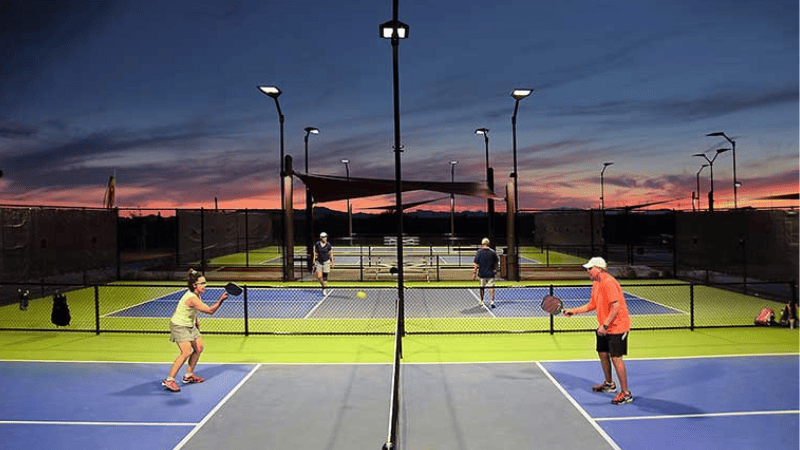
2. Placement of Poles
Properly arranging these poles around the edges of the court is crucial for uniform light spread. To decide the number of poles and where to place them, consider the court’s dimensions and configuration.
Additionally, the height at which the lights are mounted and their direction are vital in minimizing shadows and glare, ensuring the light covers the court evenly and effectively.
For example, if you’re lighting a standard tennis court measuring 36 by 18 meters, you might opt for eight poles, each positioned at the corners and midpoints of the court’s perimeter.
3. Color temperature
Opt for a lighting system that provides a cool white light, ideally within the range of 5000 to 6000 Kelvin. This specific color temperature helps mimic natural daylight, enhancing visibility and making it easier for players to see the ball and judge distances accurately.
For instance, installing LED lights that emit light at 5500 Kelvin can create an environment that feels like playing outdoors on a clear day, improving the overall playing experience.
Ask For Free Quote
Let us Respond Promptly for your Needs :)
4. Waterproofing
This feature shields the lights from rain and moisture, allowing them to function flawlessly in any weather condition. It’s wise to choose LED lights with a high waterproof rating.
For instance, LED lights rated IP65 are deemed highly effective against water ingress, making them suitable for outdoor tennis courts where exposure to rain is common.
This level of protection ensures your lighting investment is secure, maintaining optimal performance and longevity of the lights regardless of the weather.
5. Anti Glare Lens
Glare can be distracting and impair visibility, making it difficult for players to focus on the game. To combat this, choosing lighting systems equipped with anti-glare technology is important.
For example, LED lights designed with special anti-glare lenses can significantly reduce the harshness of the light, ensuring players can see clearly without discomfort. This feature is especially valuable in competitive settings, where precise vision is crucial.
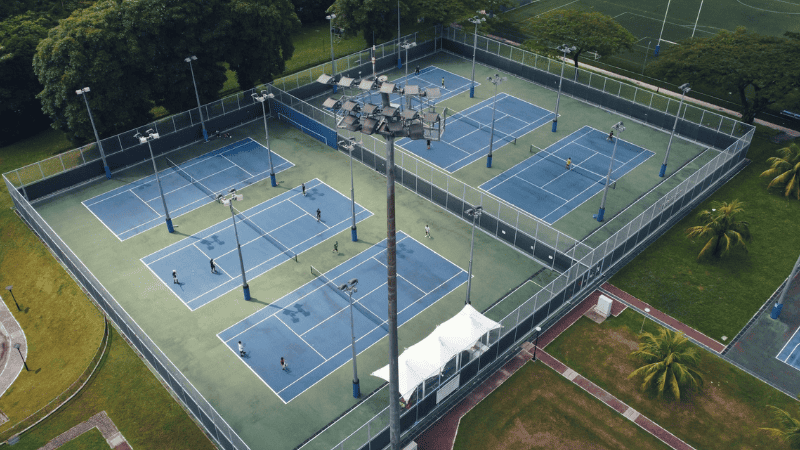
Installation Costs of Tennis Court Lighting
Here’s an installation cost breakdown based on different preferences.
Choosing the Right LED System
The cost of installing LED lighting on tennis courts can vary widely, from $30,200 to $233,200 per court. This range is influenced by the chosen LED system’s quality, the desired brightness level, and regional price differences. The total investment hinges on several key factors.
High-End Lighting for Competitive Play
For tennis clubs aiming for the highest quality lighting, particularly for national competitions, expenses can skew towards the upper end. Opting for premium LED fixtures with dimming capabilities and extended warranties can elevate the installation cost, especially when outfitting multiple courts.
Ask For Free Quote
Let us Respond Promptly for your Needs :)
Maintenance and Operational Costs
Here’s the maintenance and operational cost breakdown based on different preferences.
LED vs. Metal Halide Lighting
Comparing LED to traditional metal halide lighting reveals significant differences in operational costs. For example, lighting a double tennis court with 35,000 watts of LED lights, instead of the 70,000 watts needed for metal halide lights, shows LEDs’ efficiency.
Running LED lights for 8 hours daily at $0.12 per kWh costs about $4.2 per day ($126 monthly), whereas metal halide lights cost $8.4 daily ($252 monthly).
Budgeting for Installation
The initial setup cost for tennis court lighting can significantly vary based on the court size, required lux levels, and pole height. Casual play lighting on a single court might range from $1,000 to $3,500.
For courts designed for professional use, with higher illumination needs, the cost can jump to $5,000 to $8,000, reflecting the investment in a more advanced lighting system.
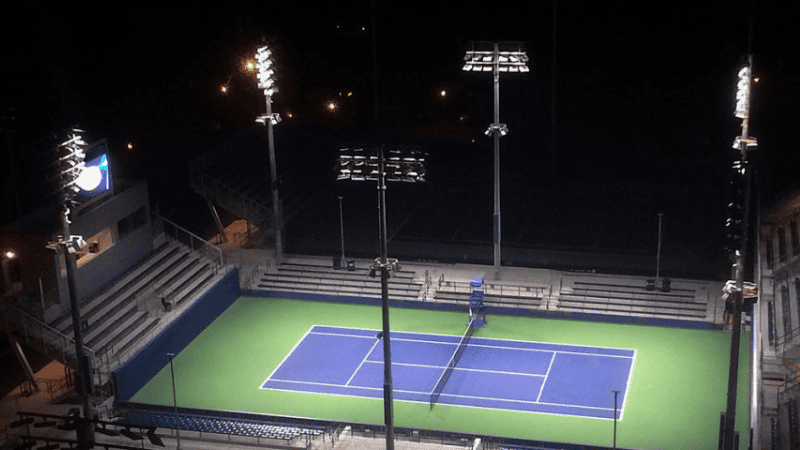
FAQs
What Is the Height of the Lights for a Tennis Court?
The appropriate height for tennis court lighting varies based on the setting and the intensity of play involved.
For casual games in parks or home courts, lights mounted at 20 to 26 feet provide adequate illumination. In contrast, athletic clubs and venues hosting competitive matches benefit from lights positioned at 26 to 39 feet above the ground.
Outdoor courts typically feature lighting poles ranging from 6 to 8 meters (about 20 to 26.7 feet) tall. The International Tennis Federation (ITF) advises that poles should stand at least 8 meters high to ensure proper coverage.
What Is the Recommended Lighting Levels for Tennis Courts?
The ideal brightness levels for tennis courts vary widely, ranging from 20 to 125 foot candles (lumens per square foot). This range is influenced by the competitive intensity and the level of play expected on the court.
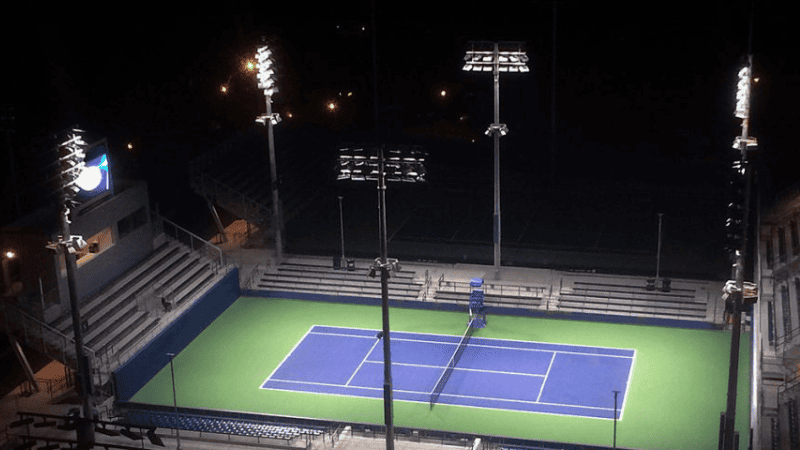
Conclusion
Selecting the right tennis court lighting system is paramount for both functionality and efficiency. Modern LED tennis lights have revolutionized how courts are lit, offering superior light quality and uniform illumination that meets the stringent standards set by the International Tennis Federation.
These LED fixtures are designed to provide bright, consistent light across the court, significantly reducing energy consumption compared to traditional metal halide lighting.
Installing LED lights in tennis facilities, whether indoor tennis courts or outdoor arenas, has become a preferred choice for their long-lasting performance and lower maintenance costs.
Notably, LED lighting systems come equipped with anti-glare lenses to ensure intense light does not hinder players’ visibility, a crucial aspect during high-stakes matches or recreational play.
Illuminate Your Game with Top-Tier Tennis Court Lighting with RC Lighting Solutions
Whether upgrading an indoor facility or lighting up an outdoor arena, adhering to the highest tennis court lighting standards is essential.
Our state-of-the-art LED solutions are designed for all levels of play, from local tournaments to international competitions, ensuring your court meets the required lux levels for optimal play conditions. Plus, the energy savings from our LED lights support sustainable practices while reducing operational costs, making them an ideal choice for any facility looking to host major events.
Don’t let poor lighting be why your court doesn’t make the cut. Upgrade to LED tennis court lighting and set a new standard for excellence in sports lighting.
Ready to Transform Your Tennis Court? Discover how RC Lighting can elevate your tennis facility with cutting-edge LED lighting solutions. Contact us now!



